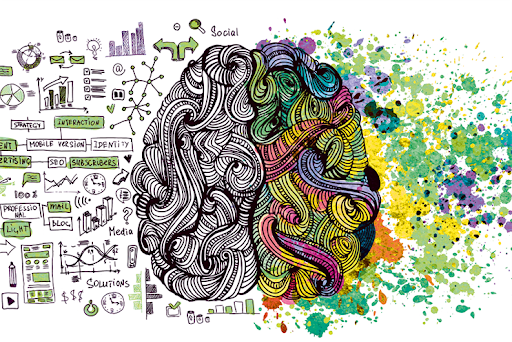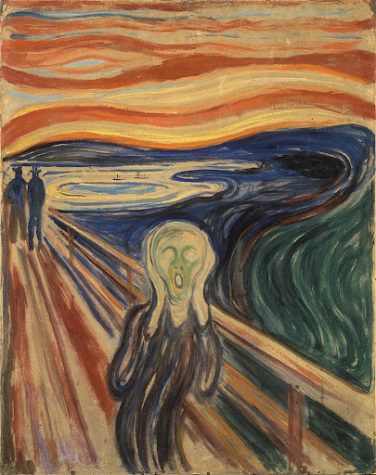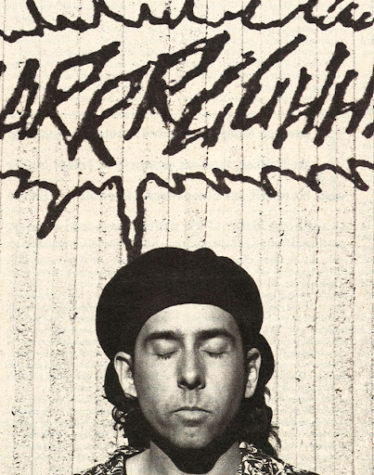Creativity in Crisis

Photo Source: https://www.campaignlive.co.uk/article/creativity-crisis-created-flat-abstract-dislocated-ads-ipa-book-says/1662353
October 13, 2022
An off-key note rang from the French horn in Lily’s hands, ignoring the pressure of her fingers directing her tired breath through the weaving coils. Emitting a long groan, Lily turned off the camera, put her instrument in its case, and tromped gloomily upstairs. A gnarled pit of frustration and anxiety bubbled in her stomach. The audition tape was due tomorrow, and none of the numerous takes had been good enough. Did she even have a chance? Other recordings would be coming in, all better than hers, why was she bothering? Was this really worth it? Music had been Lily’s escape, she never wanted it to be a pressured activity. With all the honors classes and overwhelming homework of teenage life, she’d used her talents in Band to relieve all stress and fret, a skill she could hone at her own pace and enjoy without the haunting shadow of a grade. Now, it was no longer a mode of egress from her worries. Lily is not alone in these feelings, many students struggle with finding the balance between self-expression and workload, especially when regarding their artistic passions.

Photo Source: Daily Art Magazine
The youth mental health crisis has reached an all-time high in the past generation, with suicide becoming the third highest cause of death in 15-24 year-olds. Stressors like school demands/frustrations, self-deprecation, body image issues, and difficult home lives are feeding depression and anxiety in teens today, as well as genetic mental illnesses that may go unchecked.
These stressors can lead to youth crises, where the mind reverts to a state of survival and processes information differently. The mental state of those in crisis is never good, affecting everything from routine to personality, often falling into four categories: Uncertainty, Denial, Hopelessness, and Anxiety. These effects all depend on what caused the crisis and who it is affecting, and with every effect, there is a method to “cure” the crisis. While many are wondering how to cope with these struggles, some students have found positive outlets for their depleted mental health: Creative Media.
Creative Media has been a form of self-expression, identity, and skill for millennia. Artists in specific crafts have revolutionized styles and techniques to create works of masterful and insightful pieces. However, many creators battled severe depression and crippling self-doubt: artist Vincent Van Gogh, poet Edger Alan Poe, author Ernest Hemmingway, director Tim Burton, comedian Robin Williams, musical artist NF, and playwright Sarah Kane, among others. They used their struggles in life to influence and build their careers, free themselves from past traumas, or share their current struggles as therapy. Students in the creative arts have found these methods helpful during personal torment, a time to free themselves from academic focus and show who they are and what they can do in a positive space. However, when their passions and talents become part of a grade or work, like the creators above, their escapism is often lost.

Julia Spalding, a senior artist and musician at Pentucket, says music and art create a peaceful space to deal with stressors. She is in advanced art classes within school, but her best piece was produced outside of her class. Spalding has struggled with meeting expectations and demands in her art classes and expressed that “pressure can produce an outcome in a shorter amount of time, but it doesn’t necessarily mean that it will be better; oftentimes, it will make things feel forced.” “I was calm and greatly enjoyed it because I created it independently, outside of school. I got to take my time [with] the subject, my cat, [and it] was something I really enjoyed painting.” she said during our interview.
Lily Friend, a junior musician at Pentucket, agrees that pressure changes the way creative outlets feel. “There is a fine line between fun and competition, you have to think about the endgame and the goals, like trying to get into Jazz Combo. Do you want it to be fun or do you want it to be work?” she said. “It gets problematic when the activity you used for relaxation and comfort turns into an additional stressor in your life, then where do you turn to? You want to go into it knowing what you want to get out of it.”
While pressure and stress are regarded as a negative influence on creative minds, work in theatrical arts is often elevated with the use of stress and/or trauma. Maggie Moffet, a senior actor at Watertown High in Tennessee, had this to say: “I have personally performed better when my audience feels more important to me. Auditions done in front of professionals made me more confident because I knew I wanted to impress them.” Actors are also known to use personal moments to fuel their skills. “I feel as though experiences have shaped me into being able to understand all emotions that I can portray on stage.” Moffet said. In this format, actors, rather than escaping stress, can use it to their advantage while playing a role. The character takes on their issues and dramatizes them to be completely separate from the actor, making acting a form of therapy.
I am no stranger to crises. In my short eighteen years, I have experienced three Identity crises, all brought on by school demands and personal dissolution. In those periods, I discovered muses and influences for my media, whether theatrical, literary, and/or visual. I have been in therapy for many years and worked through most of my most difficult traumas, experiences, and fears; but, while my issues shrank from massive horrors to squeaking specks, I never found a way to fully dismiss them. However, during a month or two of stress and worry last year, I created a character, a mannequin, to fill with shards of my older demons. Blaze was meant to be the heroine of my latest novel and a player in my D&D game, but she has grown to be so much more. She was a fillable creature, able to take on the bits and bobbins of old torments and stresses, of anything I had experienced, dealt with, and ready to realize. That was the key, one must have worked through such torments to pass on. I am much more confident and more myself now that Blaze is working through the final pieces of my doubt, and I have a dynamic, complicated character to use wherever I wish.
Creative media has been a beneficial force in the world since people first decided to express themselves., and while artists may have downfalls, struggles, and stressors, their art will almost always be a source of relief from these pitfalls. When they find the line between competitive drive and true self-expression, intimate artistry follows. As Lily Friend puts it. “Doing [art] requires a different kind of mental energy, unlike chores or school. You still obviously have to think and try, but it’s not the same as other assignments. It’s a way to relax and there is not a lot of pressure. I can just have fun with it and try my best, but there are no grades.”

Kat Valeri • Nov 16, 2022 at 9:58 am
This was such an interesting, engaging, and relatable article. As someone who resorts to musical and artistic outlets to help with overwhelming thoughts, I thought this article executed that perfectly.
Maddy • Nov 4, 2022 at 10:53 am
The writer of this article did an excellent job executing the information. They took a fact and gave a real-life example for it so that the reader could better understand what was so important about the fact given. It is very engaging to the reader and full of amazing facts.